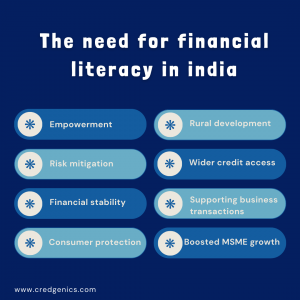Financial literacy encompasses a range of essential skills for effectively handling one’s finances, including managing personal finances, creating budgets, and making informed investment decisions. In recent times, financial products and services have gained popularity and are now accessible to individuals from diverse economic backgrounds. As such, education initiatives to prevent debt traps have taken on a more important role.
In an era where easy access to credit and a variety of financial products exist, it is more important than ever for people to understand how to manage their money wisely. India’s young and adult populations are becoming more financially literate, thanks to a number of factors, including technological development, increased awareness and expanded coverage of this topic in media. The Indian government, along with various regulatory bodies, is diligently working to promote financial literacy to prevent debt traps through initiatives such as educational courses, workshops, and schemes. The country has witnessed a significant surge in online financial services users, encompassing activities ranging from mobile banking to online payments and insurance. This widespread adoption of digital financial services has played a pivotal role in enhancing financial literacy by raising awareness and simplifying access to banking and insurance. Notably, the value of fintech transactions is projected to experience a robust compound annual growth rate (CAGR) of 20%, surging from USD 66 billion in 2019 to an estimated USD 138 billion in 2023.
The need to prevent debt traps
Debt traps refer to situations in which individuals or retail borrowers become ensnared in a cycle of increasing debt that becomes difficult or nearly impossible to repay. These situations often arise due to a combination of financial circumstances, borrowing practices, and high-interest rates, and they can have severe consequences for individuals and their financial well-being. Irrespective of the causes, increased financial literacy can prevent individuals from falling into debt traps. A holistic understanding of debt helps them gain control over their finances, inform their decisions, and avoid patterns that lead to higher debt. Financial literacy and initiatives to educate the masses contribute greatly to this endeavor.
The importance of financial literacy
- Empowerment: Financial literacy equips individuals with the knowledge and skills they need to take control of their financial state. When people understand how to budget, save, invest, and manage debt, they have the power to make sound financial decisions.
- Risk mitigation: Financial literacy helps individuals recognize and manage financial risks. It enables them to identify potential debt traps and take preventive measures to avoid falling into them.
- Long-term financial stability: People with strong financial literacy tend to achieve greater financial stability over the long term. They are more capable of handling monetary crises and accumulating wealth.
- Consumer protection: Informed consumers are less likely to fall prey to financial scams, as financial literacy acts as a shield against fraudulent schemes.
- Empowering rural development: Empowering rural communities and fostering their development can be realized through the dissemination of financial literacy. This entails raising awareness about available resources and educating individuals on how to utilize them effectively.
- Enhancing access to credit: According to a study by the Reserve Bank of India (RBI), a substantial portion of the population relies on informal sources for borrowing, often subjecting themselves to high interest rates. Robust financial education equips small-scale traders with the knowledge needed to make informed borrowing decisions and optimize available financial resources.
- Facilitating business transactions: The implementation of the Pradhan Mantri Jan Dhan Yojana has had a profound impact on financial literacy in India. By creating millions of new bank accounts, this initiative has not only expanded financial inclusion but also played a crucial role in promoting financial literacy.
- Boosting MSME growth: Micro, Small, and Medium Enterprises (MSMEs) contribute a substantial 29% to India’s GDP, with 50% of exports originating from this sector. Financial literacy plays a pivotal role in nurturing the growth of small businesses, fostering their expansion, and even paving the way for the emergence of new enterprises in the market.

Financial literacy initiatives by the government
Boosting financial inclusion and nurturing financial literacy in India has remained a top priority for both the government and various regulatory authorities, including the RBI, SEBI, IRDAI, and PFRDA. These entities have undertaken a slew of initiatives aimed at creating awareness and imparting essential financial knowledge, with each regulatory body focusing on specific areas:
- Reserve Bank of India (RBI): As the apex authority in the money market and banking sectors, the RBI has launched comprehensive financial education campaigns encompassing both fundamental and sector-specific financial education. These initiatives encompass financial literacy guides, diaries, and posters, covering critical financial principles such as savings, interest concepts, time value, and inflation. To assist businesses, RBI also disseminates information on ATMs, payment systems, Ponzi schemes, and financial awareness messages, ensuring a holistic approach to financial education.
- Securities and Exchange Board of India (SEBI): SEBI, the regulator of Indian capital and securities markets, places a strong emphasis on bolstering basic financial education and sector-specific financial knowledge. The agency conducts significant events like World Investor Week and launches mass media campaigns to raise awareness. Furthermore, SEBI maintains a dedicated investor website to provide valuable resources and information to investors.
- Insurance Regulatory and Development Authority of India (IRDAI): IRDAI, in alignment with other regulatory counterparts, actively participates in content development endeavors, creating informative brochures, handbooks, and materials. The authority has instituted a mandatory board-approved policy for insurers and organizes various seminars and quiz programs to foster financial awareness.
- Pension Fund Regulatory and Development Authority (PFRDA): PFRDA, with its focus on the pension sector, introduced the ‘Pension Sanchay’ website in 2018. This dedicated platform aims to enhance financial literacy from the perspective of retirement planning by providing valuable insights and resources.
In tandem with these regulatory efforts, the Government of India has implemented a range of schemes designed to promote financial inclusion. Initiatives such as the Pradhan Mantri Jan Dhan Yojana, Jivan Jyoti Beema, and Atal Pension Yojana are tailored to simplify banking services, elevate awareness, and disseminate knowledge about general insurance. Furthermore, the government conducts various financial literacy programs, including financial education for children, retirement planning workshops, insights into commodity futures markets, and insurance awareness campaigns targeting school students. These multifaceted endeavors collectively aim to educate and raise awareness among the nation’s young population, fostering a financially literate and inclusive society.
A perspective on India’s financial literacy
Financial literacy and education initiatives to prevent debt traps play a pivotal role in equipping individuals with the knowledge and skills needed to make informed financial decisions. By understanding budgeting, debt management, and financial risks, people can avoid falling into debt traps and work towards a secure financial future.
The growing ecosystem of financial literacy programs signifies a fundamental shift in India’s approach to financial well-being. As the nation forges ahead in the digital age, financial literacy serves as a bridge between aspirations and achievements, empowering individuals to make informed decisions, save wisely, invest strategically, and secure their financial futures.
The impact of these initiatives is not limited to individual lives alone; it ripples through the nation’s economy, fostering entrepreneurship, boosting small businesses, and bolstering financial stability. As these initiatives continue to expand and evolve, they hold the promise of empowering individuals and communities to achieve greater financial stability and success.
If you are looking to transform your debt collections strategy with the power of digital and data-powered insights, reach out to us to request an exploratory session at sales@credgenics.com or visit us at www.credgenics.com
FAQs:
- What are the financial literacy initiatives in India?
India has implemented several programs and initiatives to promote financial literacy and education among its citizens. These programs are aimed at improving financial awareness, empowering individuals to make informed financial decisions, and fostering economic inclusivity. Some notable programs for financial literacy in India include:
- Pradhan Mantri Jan Dhan Yojana (PMJDY): Launched in 2014, this flagship financial inclusion program aimed to provide every household in India with access to basic banking services. PMJDY accounts offer features like savings accounts, overdraft facilities, and insurance coverage. This initiative not only promotes financial inclusion but also serves as a platform for financial education.
- Jeevan Jyoti Bima Yojana (PMJJBY) and Suraksha Bima Yojana (PMSBY): These are government-backed insurance schemes that provide affordable life and accident insurance coverage to individuals. By offering insurance protection at minimal premiums, these schemes raise awareness about the importance of insurance as a financial tool.
- Atal Pension Yojana (APY): APY is a pension scheme designed to provide financial security to unorganized sector workers. It encourages people to save for their retirement by offering guaranteed pension benefits. APY emphasizes the importance of long-term financial planning.
- Financial Literacy Centers (FLCs): Established by several banks across India, FLCs serve as hubs for financial education. They conduct workshops, seminars, and training sessions to educate people on topics like savings, investments, and banking services.
- Digital Literacy Initiatives: With the growing emphasis on digital banking, various programs aim to improve digital literacy. These initiatives teach people how to use digital payment platforms, online banking services, and digital wallets safely and effectively.
- Financial Literacy Week: The Reserve Bank of India (RBI) organizes Financial Literacy Week annually, focusing on different financial topics each year. The week-long campaign includes workshops, seminars, and awareness programs to educate the public.
- Financial Education Apps and Websites: Several financial institutions and governmental bodies have developed mobile apps and websites dedicated to financial education. These platforms offer interactive tools, calculators, and educational content to enhance financial literacy.
- School and College Curriculum: Financial literacy is increasingly being integrated into school and college curricula. Students are taught about financial concepts, budgeting, and the importance of savings from an early age.
- Awareness campaigns: Government organizations, regulators, and financial institutions all run awareness campaigns and advertisements to inform the public about financial products, frauds, and safe financial practices.
- How is RBI facilitating financial literacy in India?
The Reserve Bank of India (RBI) plays a pivotal role in facilitating financial literacy in India through various initiatives and programs. The RBI recognizes that an informed and financially literate population is essential for the stability and development of the country’s financial system. Here are some ways in which RBI is actively involved in promoting financial literacy:
- Financial Literacy Week: RBI organizes an annual Financial Literacy Week with a specific theme each year. During this week, the central bank conducts awareness campaigns, workshops, and outreach programs across the country. These initiatives aim to educate the public on different aspects of finance, such as digital banking, responsible borrowing, and protection against financial frauds.
- Financial Literacy Centers (FLCs): RBI has established Financial Literacy Centers in collaboration with various banks. These centers act as hubs for financial education and provide free financial literacy counseling and guidance to individuals. They conduct financial literacy camps, workshops, and training sessions to impart knowledge on banking and financial products.
- School and College Curriculum: RBI advocates for the inclusion of financial literacy topics in school and college curricula. It encourages educational institutions to teach students about financial concepts, budgeting, savings, and responsible financial behavior from an early age.
- Financial Awareness Messages: RBI uses various communication channels, including print and electronic media, to disseminate financial awareness messages. These messages educate the public about banking services, safe banking practices, and the risks associated with unauthorized financial schemes.
- Consumer Education: RBI has established the Banking Ombudsman Scheme, which includes provisions for addressing consumer complaints related to banking services. This helps consumers understand their rights and how to seek redress in disputes.
- Financial Education Apps and Materials: RBI has developed mobile apps and educational materials that are available to the public free of cost. These resources provide information on financial concepts, banking products, and tips for financial planning.
- Financial Inclusion: RBI’s efforts to promote financial inclusion, such as the Jan Dhan Yojana, have a significant impact on enhancing financial literacy. By bringing unbanked populations into the formal financial system, individuals gain exposure to banking services and financial education.
- Collaboration with Stakeholders: RBI collaborates with various stakeholders, including banks, non-banking financial institutions, and government bodies, to collectively promote financial literacy through campaigns, seminars, and workshops.





